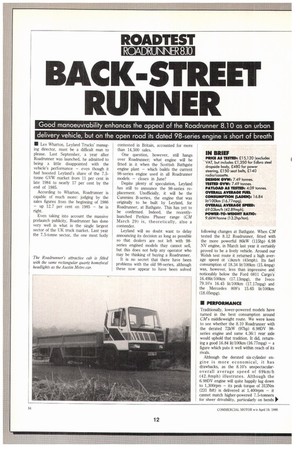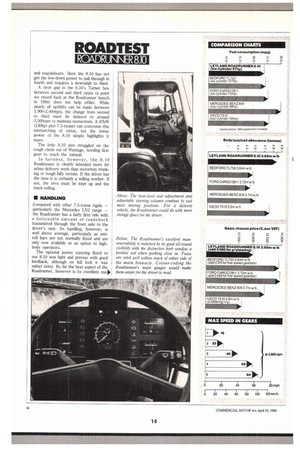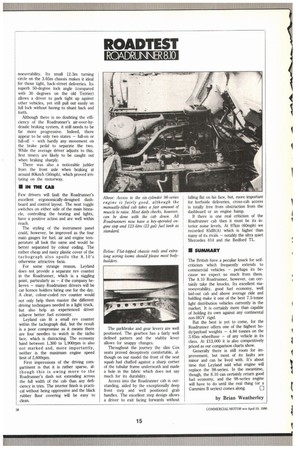BACK-STREET RUNN
Page 128

Page 130

Page 131

If you've noticed an error in this article please click here to report it so we can fix it.
Good manoeuvrability enhances the appeal of the Roadrunner 8.10 as an urban delivery vehicle, but on the open road its dated 98-series engine is short of breath
• Les Wharton, Leyland Trucks' managing director, must be a difficult man to please. Last September, a year after Roadrunner was launched, he admitted to being a little disappointed with the vehicle's performance even though it had boosted Leyland's share of the 7.5tonne GVW market from 11 per cent in late 1984 to nearly 17 per cent by the end of 1985.
According to Wharton, Roadrunner is capable of much more: judging by the sales figures from the beginning of 1986 up 12.7 per cent on 1985 he is right.
Even taking into account the massive prelaunch publicity. Roadrunner has done very well in what is the single largest sector of the UK truck market. Last year the 7.5-tonne sector, the one most hotly contested in Britain, accounted for more than 14,500 sales.
One question, however, still hangs over Roadrunner; what engine will be fitted in it when the Scottish Bathgate engine plant which builds the current 98-series engine used in all Roadrunner models closes in June?
Depite plenty of speculation, Leyland has still to announce the 98-series replacement. Unofficially, it will be the Cummins B-series, the engine that was originally to be built by Leyland, for Roadrunner, at Bathgate. This has yet to be confirmed. Indeed, the recentlylaunched Perkins Phaser range (CM March 29) is, theoretically, also a contender.
Leyland will no doubt want to delay announcing its decision as long as possible so that dealers are not left with 98series engined models thay cannot sell, but this does not help any operator who may be thinking of buying a Roadrunner.
It is no secret that there have been problems with the old 98-series, although these now appear to have been solved following changes at Bathgate. When CM tested the 8.12 Roadrunner, fitted with the more powerful 86kW (115hp) 6.98 NV engine, in March last year it certainly proved to be a lively vehicle. Around our Welsh test route it returned a high average speed ot 731on/h (45mph). Its fuel consumption of 18.34 lit/100km (15.4mpg) was, however, less than impressive and noticeably below the Ford 0811 Cargo's 16.49U/100km (17.13mpg), the lveco 79.10's 16.45 lit/100km (17.17mpg) and the . Mercedes 809's 15.65 lit/100km (18.05mpg).
• PERFORMANCE Traditionally, lower-powered models have turned in the best consumption around CM's middleweight route. We were keen to see whether the 8.10 Roadrunner with the derated 72kW (97hp) 6.98DV 98series engine and same 4.36:1 rear axle would uphold that tradition. It did, returning a good 16.84 lit./100lan (16.77mpg) a figure which puts it well within reach of its rivals.
Although the derated six-cylinder engine is more economical, it has drawbacks, as the 8.10's unspectacularoverall average speed of 69km/h (42.8mph) illustrates. Although the 6.98DV engine will quite happily lug down to 1,300rpm its peak torque of 313Nm (231 lbft) is delivered at 1,400rpm it cannot match higher-powered 7.5-tonners for sheer drivability, particularly on bends p
and roundabouts. Here the 8.10 has not got the low-down power to pull through in fourth and requires a downshift to third.
A clear gap in the 8.10's Turner box between second and third ratios (a point we raised back at the Roadrunner launch in 1984) does not help either. While nearly all upshifts can be made between 1,900-2,000rpm. the change from second to third must be delayed to around 2,500rpm to maintain momentum. A 97kW (130hp) plus 7.5-tonner can overcome this mismatching of ratios, but the lower power of the 8.10 simply highlights it more.
The little 8.10 also struggled on the tough climb out of Wantage, needing first gear to reach the summit.
In fairness, however, the 8.10 Roadrunner is clearly intended more for urban delivery work than motorway trunking or tough hilly terrain. If the driver has the time it is certainly a willing worker. If not, the revs must be kept up and the truck rolling.
• HANDLING
Compared with other 7.5-tonne rigOs — particularly the Mercedes LN2 range — the Roadrunner has a fairly firm ride with a noticeable amount of roadshock transmitted through the front axle to the driver's seat. Its handling, however, is well above average, particularly as antiroll bars are not normally fitted and are only now available as an option to highbody operators.
The optional power steering fitted to our 8.10 was light and precise with good feedback, although on full lock it was rather noisy. By far the best aspect of the Roadrunner, however is its excellent ma* Below: The Roadrunner's excellent manoeuvrability is matched by its good all-round visibility with the distinctive kerb window a positive aid when parking close in. Fuses are sited well within reach of either side of the main binnacle. Colour-coding the Roadrunner's main gauges would make them easier for the driver to read. noeuvrability. Its small 12.3m turning circle on the 3.65m chassis makes it ideal for those tight, back-street deliveries. Its superb 50-degree lock angle (compared with 30 degrees on the old Terrier) allows a driver to park tight up against other vehicles, yet still pull out easily on full lock without having to shunt back and forth.
Although there is no doubting the efficiency of the Roadrunner's air-over-hydraulic braking system, it still needs to be far more progressive. Indeed, there appear to be only two states — full-on or full-off — with hardly any movement on the brake pedal to separate the two. While the average driver adjusts to this, first timers are likely to be caught out when braking sharply.
There was also a noticeable judder from the front axle when braking at around 80km/h (50mph), which proved irritating on the motorway.
• IN THE CAB
Few drivers will fault the Roadrunner's excellent ergonomically-designed dashboard and control layout. The neat toggle switches on either side of the main binnacle, controlling the heating and lights, have a positive action and are well within reach.
The styling of the instrument panel could, however, be improved as the four main gauges for fuel, air and engine temperature all look the same and would be better separated by colour coding. The rather cheap and nasty plastic cover of the tachograph also spoils the 8.10's otherwise attractive facia.
For some strange reason, Leyland does not provide a separate rev counter in the Roadrunner, which is a niggling point, particularly as — if the company believes — many Roadrunner drivers will be car licence holders hiring one for the day. A clear, colour-coded rev counter would not only help them master the different driving techniques needed in a light truck, but also help an experienced driver achieve better fuel economy.
Leyland can fit a small rev counter within the tachograph dial, but the result is a poor compromise as it means there are four needles to watch in the cache face, which is distracting. The economy band between 1,300 to 1,900rpm is also not marked and, more importantly, neither is the maximum engine speed limit of 2,600rpm.
First impressions of the driving compartment is that it is rather sparse, although this is owing more to the Roadrunner's dash not extending across the full width of the cab than any deficiency in trim. The interior finish is practical without being oppressive and the black rubber floor covering will be easy to clean. Above: Access to the six-cylinder 98-series engine is fairly good, although the manually-tilted cab takes a fair amount of muscle to raise. Most daily checks, however, can be done with the cab down. All Roadrunners now have a key-operated engine stop and 123-litre (23 gal) fuel tank as standard.
The parkbrake and gear levers are well positioned. The gearbox has a fairly well defined pattern and the stubby lever allows for snappy changes.
Throughout the journey the slim Cox seats proved deceptively comfortable, although on our model the front of the seat squab had chaffed against a sharp corner of the tubular frame underneath and made a hole in the fabric which does not say much for its durability.
Access into the Roadrunner cab is outstanding, aided by the exceptionally deep front step and well positioned grab handles. The excellent step design allows a driver to exit facing forwards without falling flat on his face, but, more important for kerbside deliveries, cross-cab access is totally free from obstruction from the dashboard or an engine hump.
If there is one real criticism of the Roadrunner cab then it must be its interior noise levels. At 97km (60mph) we recorded 85dB(A) which is higher than many of its rivals — notably the ultra quiet Mercedes 814 and the Bedford TL.
• SUMMARY
The British have a peculiar knack for selfcriticism which frequently extends to commercial vehicles — perhaps its because we expect so much from them. The 8.10 Roadrunner, however, can certainly take the knocks. Its excellent manoeuvrability, good fuel economy, well laid-out cab and above average ride and haldling make it one of the best 7.5-tonne light distribution vehicles currently in the market. It is certainly more than capable of holding its own against any continental non-HGV rigid.
But the best is yet to come, for the Roadrunner offers one of the highest body/payload weights — 4.84 tonnes on the 3.65m wheelbase — of any vehicle in its class. At £13,000 it is also competitively priced as our comparison charts show.
Generally there is still room for improvement, but most of its faults are minor and can be lived with. It's about time that Leyland said what engine will replace the 98-series. In the meantime, though, the 8.10 can certainly return good fuel economy, and the 98-series engine will have to do until the real thing (or a Cummins B series) comes along.
by Brian Weatherley




























































































































































































